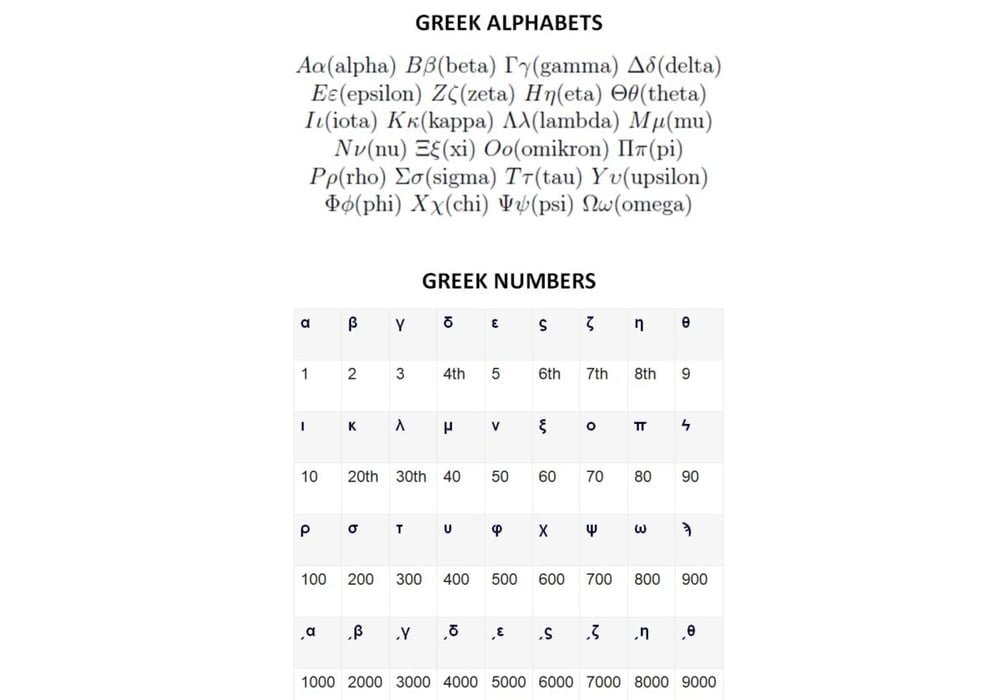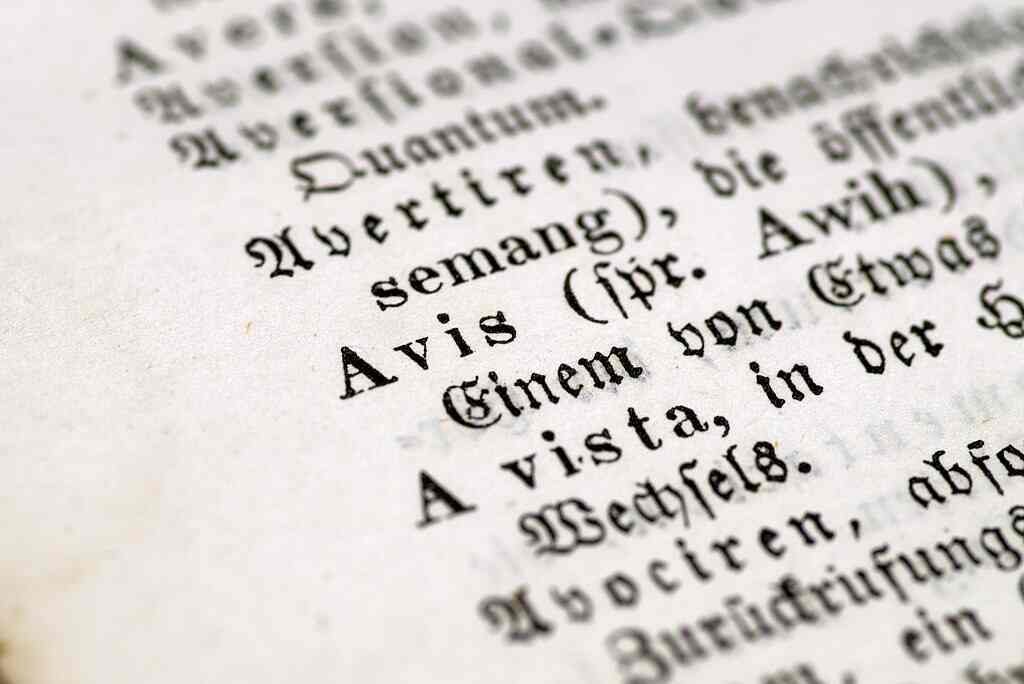Greek Alphabets
The Greek alphabets has been used to write Greek since the late 9th or early 8th century BC. The Greek alphabet is derived from the earlier Phoenician alphabet, and was the 1st alphabetic script to have different letters for vowels as well as consonants.
In Archaic and early Classical times, the Greek alphabets existed in many different local variants, but, by the late 4th century BC, the Eucleidean alphabet, with its 24 four letters, written from alpha to omega, had become the standard. This version is still used to write Greek to this day.
| Letter | Uppercase | Lowercase |
|---|---|---|
| Alpha | Α | α |
| Beta | Β | β |
| Gamma | Γ | γ |
| Delta | Δ | δ |
| Epsilon | Ε | ε |
| Zeta | Ζ | ζ |
| Eta | Η | η |
| Theta | Θ | θ |
| Iota | Ι | ι |
| Kappa | Κ | κ |
| Lambda | Λ | λ |
| Mu | Μ | μ |
| Nu | Ν | ν |
| Xi | Ξ | ξ |
| Omicron | Ο | ο |
| Pi | Π | π |
| Rho | Ρ | ρ |
| Sigma | Σ | σ |
| Tau | Τ | τ |
| Upsilon | Υ | υ |
| Phi | Φ | φ |
| Chi | Χ | χ |
| Psi | Ψ | ψ |
| Omega | Ω | ω |
Greek Numerals
The Greek numbers are represented by letters as digits.
| α | β | γ | δ | ε | ζ | η | θ | ι | κ | λ | μ | ν | ξ | ο | π | ρ | σ | τ | υ | φ | χ | ψ | ω |
|---|---|---|---|---|---|---|---|---|---|---|---|---|---|---|---|---|---|---|---|---|---|---|---|
| 1 | 2 | 3 | 4th | 5 | 6th | 7th | 8th | 9 | 10 | 11 | 12th | 13 | 14th | 15th | 16 | 17th | 18th | 19th | 20th | 21 | 22nd | 23 | 24 |
Modern Greek Numerals
| 0 | μηδέν | [ miˈðɛn ] | ||||||
| 1 | ένας, μία, ένα (1) | [ ˈƐnas ], [ ˈmia ], [ ˈɛna ] | 11 | ένδεκα / έντεκα | [ ˈƐnðɛka ] / [ ˈɛndɛka ] | |||
| 2 | δύο | [ ˈÐiɔ ] | 12th | δώδεκα | [ ˈÐɔðɛka ] | 20th | είκοσι | [ ˈIkɔsi ] |
| 3 | τρεις, τρεις, τρία (1) | [ tris ], [ ˈtria ] | 13 | δεκατρείς, -τρία (1) | [ ðɛkaˈtria ] | 30th | τριάντα | [ triˈanda ] |
| 4th | τέσσερεις, -ρις, τέσσερα (1) | [ ˈTɛsɛris ], [ ˈtɛsɛra ] | 14th | δεκατέσσερις, -α (1) | [ ðɛkaˈtɛsɛra ] | 40 | σαράντα | [ saˈranda ] |
| 5 | πέντε | [ ˈPɛndɛ ] | 15th | δεκαπέντε | [ ðɛkaˈpɛndɛ ] | 50 | πενήντα | [ pɛˈninda ] |
| 6th | έξι | [ ˈƐksi ] | 16 | δεκαέξι | [ ðɛkaˈɛksi ] | 60 | εξήντα | [ ɛˈksinda ] |
| 7th | εφτά (also επτά (2) ) | [ ɛfˈta ] ([ ɛpˈta ]) | 17th | δεκαεφτά | [ ðɛkaɛfˈta ] | 70 | εβδομήντα | [ ɛvðɔˈminda ] |
| 8th | οχτώ (also οκτώ (2) ) | [ ɔxˈtɔ ] ([ ɔkˈtɔ ]) | 18th | δεκαοχτώ | [ ðɛkaɔxˈtɔ ] | 80 | ογδόντα | [ ɔɣˈðɔnda ] |
| 9 | εννιά (also εννέα (2) ) | [ ɛˈɲa ] ([ ɛnˈɛa ]) | 19th | δεκαεννιά | [ ðɛkaɛˈɲa ] | 90 | ενενήντα | [ ɛnɛ’ninda ] |
| 10 | δέκα | [ ˈÐɛka ] | 20th | είκοσι | [ ˈIkɔsi ] | 100 | εκατό (ν) | [ ɛkaˈtɔ (n) ] |
| 21 | είκοσι ένα (1) | 101 | εκατόν ένα (1) | |||||
| 22nd | είκοσι δύο | 200 | διακόσιοι, -κόσιες, -κόσια (1) | [ ðiaˈkɔsça ] | ||||
| 23 | είκοσι τρία (1) | 300 | τριακόσιοι, – κόσιες, -κόσια (1) | [ triaˈkɔsça ] | ||||
| 24 | είκοσι τέσσερα (1) | 1000 | χίλιοι, χίλιες, χίλια (1) | [ ˈÇiʎa ] | ||||
| 25th | είκοσι πέντε | 2000 | δύο χιλιάδες | [ çiˈʎaðɛs ] |
Greek numbers between 1000 and 9999
The numbers between 1000 and 9999 can also be displayed: For this purpose, the first number letter was multiplied by a thousand by adding a diacritical mark. In handwriting, one usually uses a character in the form of a small hook open to the left, in front of the number at the top left. In letterpress printing, the subscript apostrophe ͵ (Αριστερή Κεραία) has prevailed, in Unicode U + 0375.
α β γ δ ε ϛ ζ η θ 1 2 3 4th 5 6th 7th 8th 9 ι κ λ μ ν ξ ο π ϟ 10 20th 30th 40 50 60 70 80 90 ρ σ τ υ φ χ ψ ω ϡ 100 200 300 400 500 600 700 800 900 ͵α ͵β ͵γ ͵δ ͵ε ͵ϛ ͵ζ ͵η ͵θ 1000 2000 3000 4000 5000 6000 7000 8000 9000
The power extension to 10 to the power of 36
Another, but very seldom used system for the representation of large numbers can be found in Apollonios von Perge, who, according to the testimony of Pappus of Alexandria , differentiated myriads of the first, second, third, etc. to the ninth order in increasing power by adding the Μ with overwritten the characters α to θ = 1 to 9, which consequently were no longer evaluated as a multiplier, but as the exponent of a power. To represent the number 5,462,360,064,000,000, this resulted in a spelling like the following:
| ͵EYZB | ͵ΓX | ͵FY | |||||
| 10000 3 × 5462 | + | 10000 2 × 3600 | + | 10000 1 × 6400 | |||
Sources: PinterPandai, Rapid Tables, Illinois.edu, MIT






